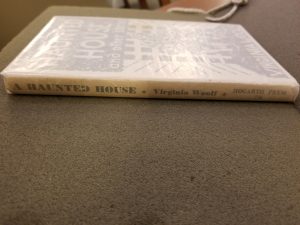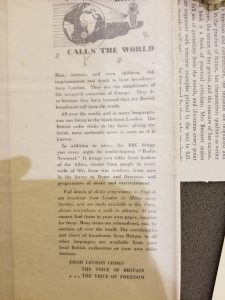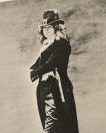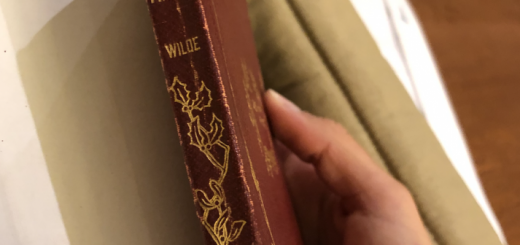Virginia Woolf “A Haunted House and Other Stories” by Devon V.
This small, thin, first edition book, containing only short stories, was published by Virginia and Leonard Woolf’s personal printing press, the Hogarth Press, in 1943. With just this information, we know that the book was publis hed posthumously as Virginia Woolf took her life in 1941. Immediately upon opening the book’s front flap, we can see that the bold, bleak, impressionistic painting that adorns the book jacket was created by Vanessa Bell, Virginia Woolf’s sister. Then immediately after, we find the forward written by her husband Leonard Woolf. Already, we get an overwhelming feeling of just how personal and intimate this collection is to have been produced by people so close with Virginia Woolf, and this feeling of privacy and closeness, combined with how small and portable the book is itself, brings me to believe that we as reader should employ a closely intimate reading of the works. The bleakness, and relatively plain, book jacket stands in stark contrast of the vivid and colorful descriptions that fill each story. This effect, possibly done with intention, helps focus the reader’s attention not on the superficial qualities of the presentation of books, but rather the content and literary merit contained within as being the true beauty.
hed posthumously as Virginia Woolf took her life in 1941. Immediately upon opening the book’s front flap, we can see that the bold, bleak, impressionistic painting that adorns the book jacket was created by Vanessa Bell, Virginia Woolf’s sister. Then immediately after, we find the forward written by her husband Leonard Woolf. Already, we get an overwhelming feeling of just how personal and intimate this collection is to have been produced by people so close with Virginia Woolf, and this feeling of privacy and closeness, combined with how small and portable the book is itself, brings me to believe that we as reader should employ a closely intimate reading of the works. The bleakness, and relatively plain, book jacket stands in stark contrast of the vivid and colorful descriptions that fill each story. This effect, possibly done with intention, helps focus the reader’s attention not on the superficial qualities of the presentation of books, but rather the content and literary merit contained within as being the true beauty.
Leonard Woolf chooses that the titular piece, “A Haunted House”, be the introductory story for the book. I believe that  this then gives a light atmosphere to the rest of the collection. Woolf’s work can often come across as dense and loquacious, but the simplicity of “The Haunted House” with its endearing tenderness, makes me think that the rest of the works are meant to be pondered almost in reverie.
this then gives a light atmosphere to the rest of the collection. Woolf’s work can often come across as dense and loquacious, but the simplicity of “The Haunted House” with its endearing tenderness, makes me think that the rest of the works are meant to be pondered almost in reverie.
The title, on the whole, does not bring justice for the sort of elegance and enigmas presented in Woolf’s work. One may conjure up images up the macabre and the grotesque from such a title, but the truth behind the name underscores a faint humor. Woolf’s work is essentially driven by description and the wistfulness of her mind, without any concrete destination, and entirely entranced by the flow of the world. The title highlights a house, a haunting, but none of these aspects play any meaningful role in the story. It is the freedom of the ghosts from any limitations of being human, the perseverance of their love, and the ability to be completely separate from the rest of the world that strikes the reader.
The other stories, including “The Lady in the Looking Glass” and “The Mark on the Wall”, give more detail on how deeply personal Woolf’s writing was as she focused on an overarching idea of femininity. Almost of all the stories revolve around the perspective of a female narrator, and by placing them in a compendium, give a feeling of a single narrator that persists onto the next story, rather than being discrete, disjoint stories.













Recent Comments